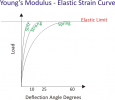Willie71
Warren J. Krywko
- Joined
- Feb 23, 2013
- Messages
- 12,214
If you think of the knife as a spring, it makes sense. Springs are rated in pounds per inch or some similar measure. Each inch of bend takes an increase of force at the rate of the spring. Once you exceed the yield point, the force no longer increases, as it breaks or bends. All same shaped blades flex at the same amount of force until exceeding the yield point.
A common example is motor sports. People mistakenly believe a chromoly frame is stiffer than a mild steel frame. There may be a slight difference based on alloying, but the two frames will feel basically identical, until reaching failure. At that point the chromoly frame will be able to spring back, while the mild steel frame will take a set. It is stronger in the total load it can take, but both have the same feel at loads up to the max load the mild steel frame can handle.
A common example is motor sports. People mistakenly believe a chromoly frame is stiffer than a mild steel frame. There may be a slight difference based on alloying, but the two frames will feel basically identical, until reaching failure. At that point the chromoly frame will be able to spring back, while the mild steel frame will take a set. It is stronger in the total load it can take, but both have the same feel at loads up to the max load the mild steel frame can handle.

